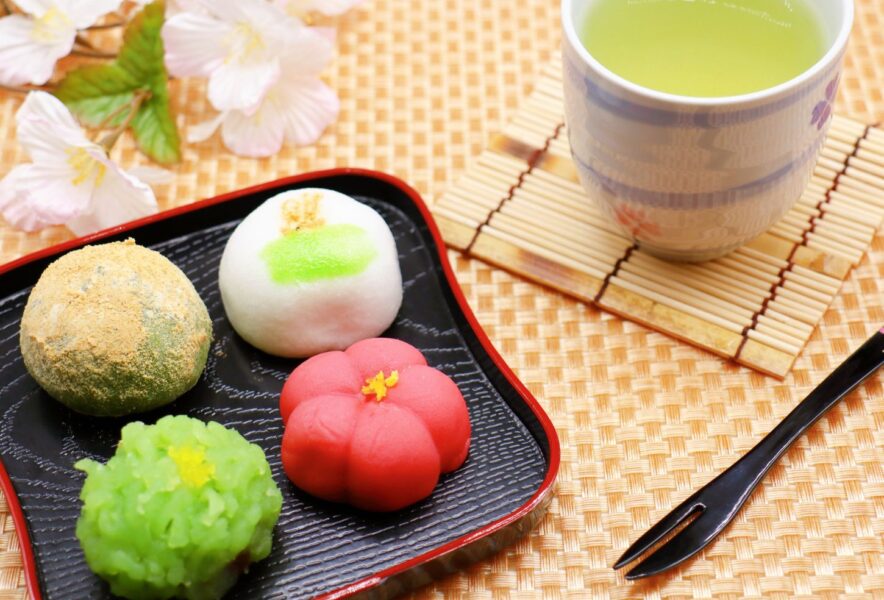Wagashi, Japan’s traditional confectionery, represents much more than just a dessert—it is a reflection of the country’s rich history, deep cultural connections, and the beauty of its changing seasons. From centuries-old sweet shops in Tokyo to delicious treats found at modern convenience stores, wagashi offers a unique perspective on Japanese culinary traditions. In this guide, we’ll explore some of Tokyo’s most historic wagashi stores, the types of wagashi you must try, and why buying from these long-established shops is an unforgettable experience.
- The History of Wagashi: A Tradition Rooted in Japan’s Culture
- Main Types of Wagashi: From Mochi to Dorayaki
- Conveniently Accessible Wagashi: Delicious Treats at Your Local Konbini
- Why You Should Visit Tokyo’s Historic Sweet Shops
- A Guide to Tokyo’s Oldest Wagashi Stores: Toraya, Tsuruya Yoshinobu, Eitaro, and Akasaka Aono
The History of Wagashi: A Tradition Rooted in Japan’s Culture
Wagashi dates back over a millennium, with its earliest forms appearing during the Nara period (710–794) when Japan started using sugar imported from China. These early sweets were often used as offerings in Buddhist rituals. However, it was during the Edo period (1603–1868) that wagashi flourished as an art form, particularly in relation to tea ceremonies. As matcha (green tea) became popular, the need for sweets to balance the tea’s bitterness grew, and wagashi evolved into the delicately crafted confectioneries we know today. The influence of Japan’s natural beauty is evident in wagashi, which often reflects seasonal elements such as cherry blossoms, maple leaves, and snow, making them as much a feast for the eyes as they are for the taste buds.
Main Types of Wagashi: From Mochi to Dorayaki
Wagashi comes in various forms, textures, and flavors, each carrying its own cultural significance. Below are some of the most beloved varieties:
- Mochi: Made from glutinous rice, mochi is soft, chewy, and commonly enjoyed during the New Year’s celebrations. Variations like daifuku (mochi filled with sweet red bean paste) and kusa mochi (mochi flavored with mugwort) are especially popular year-round.
- Dorayaki: A beloved snack, especially famous thanks to the character Doraemon. It consists of two fluffy pancakes filled with sweet anko (red bean paste).
- Yokan: This firm, jelly-like dessert is made from red bean paste and agar, and it is both visually striking and long-lasting. Yokan is a common gift item in Japan due to its rich flavor and elegant appearance.
- Nerikiri: Known for its beautiful presentation, nerikiri is often crafted to represent seasonal flowers, animals, or scenery, making it a perfect addition to tea ceremonies.
Conveniently Accessible Wagashi: Delicious Treats at Your Local Konbini
For those who are always on the go, Japan’s famous konbini (convenience stores) make it easy to grab a quick taste of wagashi. The convenience and affordability of these snacks allow travelers and locals alike to indulge in traditional sweets without visiting specialty shops. Some popular konbini options include:
- Daifuku: A mochi treat filled with anko or seasonal fruits like strawberries. Ichigo daifuku (strawberry-filled daifuku) is a springtime favorite.
- Mitarashi Dango: Grilled rice dumplings skewered and coated in a sweet soy glaze, offering a delicious balance of savory and sweet flavors.
- Dorayaki: Often found in pre-packaged forms at konbini, these tasty pancakes with red bean filling are a convenient way to enjoy this traditional snack.
Why You Should Visit Tokyo’s Historic Sweet Shops
While konbini offer convenience, there is something uniquely special about visiting one of Tokyo’s historic wagashi shops. These shops often have centuries of history, with recipes and techniques passed down through generations. Their dedication to traditional craftsmanship is evident in the care they put into each piece of wagashi. Additionally, many of these shops offer seasonal specialties or limited-edition treats that can’t be found anywhere else, making them a must-visit for anyone wanting to experience authentic Japanese sweets.
By visiting these historic shops, you can not only taste wagashi in its finest form but also gain a deeper appreciation for the cultural and historical significance behind each creation.
A Guide to Tokyo’s Oldest Wagashi Stores: Toraya, Tsuruya Yoshinobu, Eitaro, and Akasaka Aono
Tokyo is home to several renowned wagashi shops, each offering its own signature products and a rich history. Here’s a guide to some of the oldest and most respected wagashi stores in the city:
- Toraya: Established during the Muromachi period (1336–1573), Toraya is one of Japan’s oldest and most prestigious wagashi shops. Known for its yokan and beautifully crafted nerikiri, Toraya continues to uphold its reputation for exquisite craftsmanship and quality. Official Website
- Tsuruya Yoshinobu: Originally from Kyoto, this shop dates back to the Edo period (1603–1868) and is famous for its intricate nerikiri and seasonal wagashi that celebrate Japan’s festivals and natural beauty. Official Website
- Eitaro: Founded in the early Edo period, Eitaro specializes in ame (Japanese candy) and traditional wagashi like dorayaki. Their dedication to quality has allowed them to maintain their status as one of Tokyo’s most iconic sweet shops. Official Website
- Akasaka Aono: Established in 1899, this shop is renowned for its mochi and yokan, offering traditional Japanese sweets made using techniques that have been perfected over generations. Official Website
These shops not only offer delicious wagashi but also provide a glimpse into Japan’s rich culinary history. Each store has its own unique charm, making it an unforgettable experience for anyone visiting Tokyo.

Comment